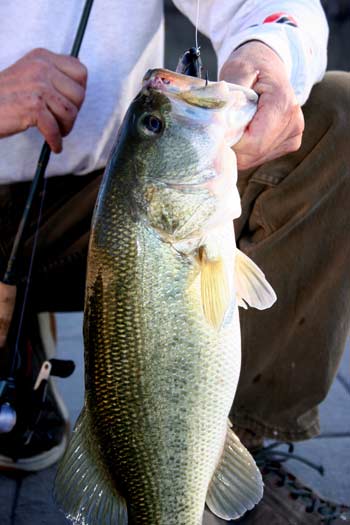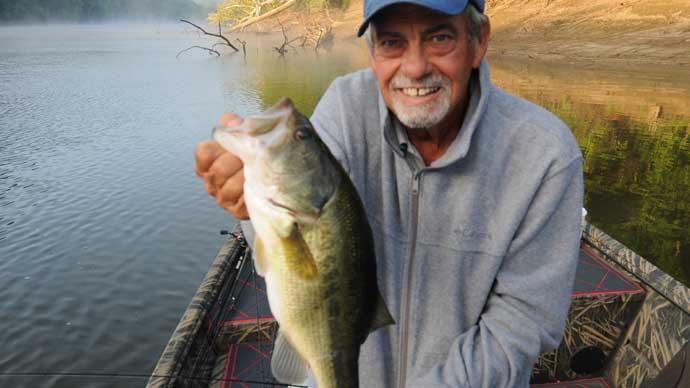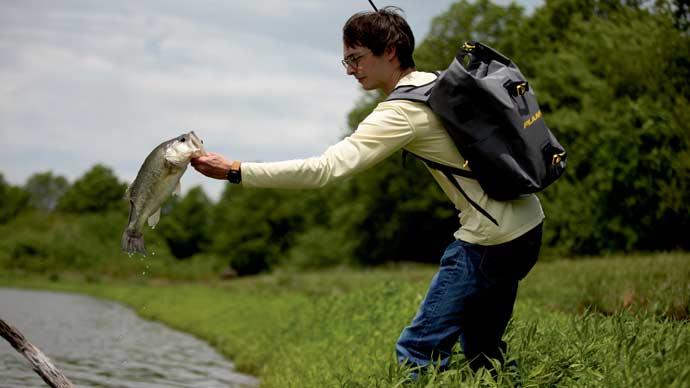
By now, I'm betting that most of your New Year's resolutions have been forgotten or given up. But if one of those resolutions was to get better at finding and catching bass this year, we've got you covered. Decades of talking to fishermen, fishing in the backseat, and interviewing fishermen means you get a lot of good info from various anglers. So here are my top 8 tips for becoming a better bass fisherman.
Know How To Pattern Bass – Rick Clunn
I made this number one because finding the fish is often the most challenging part of bass fishing. Once you know where they are, you can decide on a lure and technique that will get to them, but you do have to find them first. I was lucky enough to attend a seminar years ago where Rick Clunn was one of the speakers, and he talked about how to pattern bass. He has three steps he goes through.
Rick says that a bass is a bass wherever it lives, and he’s proven that by winning tournaments all over the country -- everywhere from southern rivers to deep western reservoirs. He says they are simply animals with particular needs and instincts. Learn how they respond to biological stimuli, and you'll know where to look for them.
Before you even get to the lake, you can figure out the seasonal pattern, which is step one of three. Second is the current pattern – what they're doing today. Third is the specific pattern. Rick says only 10 to 15 percent of anglers will ever get to the point where they can get to the third step. Accept the challenge!
The seasonal pattern lets you eliminate a ton of water before you even get there. Take a lake map and divide it into sections. Deep clear areas are section 1. Midrange depths are in section 2. Shallow coves and inlets are section 3. Add a 4th section for a river or creek into which you can get the boat. He relies on experience, notes, records, and published tournament results to decide which sections to fish in. That will give you a good idea of which sections to concentrate on. He bases his choices on the time of year, water temperature, and conditions (like weather and water visibility)
To find the current pattern (#2), he goes to one of the sections he determined in step one and fishes it like a pond. Identify all visible objects in the water – your depthfinder can help here. At the time I heard Clunn, all we had were flashers! He says bass will relate to some object 98% of the time.
Once you’ve identified the objects, which can be things like a stump field, floating vegetation, submerged vegetation, small channels, piers, or sunken items, work every one until you feel like you've covered it thoroughly. Eventually, you'll see what type of stuff the bass relate to. So, there's your current pattern.
But…there are two kinds of current patterns: individual fish patterns and concentration patterns. So if you catch three fish in a channel, that's a concentration. One fish off a stump is an individual. So to replicate that, go from section to section all day and fish just that pattern. If it’s small channels, ignore all the other stuff. If you find a school of bass, stay there! But don’t fish between patterns.
The specific pattern is where most of us get left behind. He says only elite fishermen get here and may not even realize they're doing it. For instance, if Gary Dobyns is throwing a jerkbait on a bank and catches a couple of fish that both came from the north side of a tree in five feet of water, he might go down the bank and only throw on the north side of trees without even realizing he's doing it. That's a specific pattern. It's knowing what the fish use and how they use it.
A final important tip from Rick: your most crucial fishing asset is your head, not your tackle. The only valid reason for selecting a bait is confidence, and the essential function of a lure is to find fish. His top three lures in all seasons and conditions are spinnerbaits, crankbaits, and plastic worms or jigs.
Fish Your Strengths – Gary Dobyns
Dobyns is a power fisherman. He hates finesse fishing and avoids it if at all possible. But one tournament in the dead of winter had him using a dropshot in fifteen feet of water and struggling to get a bite. By mid-morning, he was frustrated and getting irritated as well. That's when a buddy of his came by and stopped to chat.
Dobyns was astonished when his buddy told him he had five good keepers in the well. He was even more astonished and chagrined to hear that his buddy had caught them all on the bank in less than five feet of water!
That tournament was the last time Gary paid attention to "common knowledge." After all, everyone knows you have to fish deep in winter, right? Gary says to heck with that. "Fish are where you find them," he says, "and I find them shallow almost all the time." Not only that, but fishing the way he loves to fish keeps him in a good mood all day, and that's another key to being a better fisherman!
Be Out Of Your Mind
A sports psychologist I know helps a lot of athletes, including fishermen. You might think psychology is a bunch of gobbledygook, but Clunn and Dobyns are great examples of what the psychologist tells his patients. Clunn has confidence because he catches fish, and he catches fish because he has confidence.
Confident fishing starts at home, in the truck, or even on breaks at work. Picture yourself catching a bass. Imagine it in all the detail you can – how the sun feels, the smell of the lake, how the hookset feels, and especially how you feel when your hand pulls the fish into the boat.
When you’re fishing, hold on to that feeling. Clunn calls it “the zen of fishing." Nothing else intrudes when your mind is so focused on fishing. You don't even hear anything that isn't directly related to what you are doing. My buddy always said, "Thoughts are things," and it's true. So don't let dock talk or anything else steal your joy!
Be Prepared
I was a press observer at many of the Red Man All-American tournaments, and once I was paired with Larry Hines from California. We were running down the river, and the boat suddenly stopped. It was some electrical thing. I swear I'm telling you the truth – Larry fixed it with the pop top from a soda can! Then the boat got a loose connection, and he fixed that with a Band-Aid!
After we finally got to his spot, he got a fish on, dropped his rod overboard, and went in after it! Then, while I was still wondering if helping him back into the boat was against the rules, he pulled himself aboard and started fishing again. "If this was my boat," he said, "none of this would have happened!"
Experienced fishermen are prepared for just about anything. Many guys I know even carry a spare trolling motor! They keep their gear and their tackle in top shape, and they keep a way to fix most things with them in the boat as well. It’s another way to have that zen – nothing ruins a day on the water like boat problems or broken reels. Keeping your equipment in good shape is another way to be a better fisherman.
Make Every Hookset Count
Gary Dobyns once told me that the most common mistake he sees fishermen make is in their hookset. Rather than reeling to get a good position, they make a snap set and don't get the fish. Of course, Gary keeps his hooks sharp and his line strong, but having a strong, sharp hook and a sturdy line is just the beginning.
The rod's position and the line's tautness when you start your hookset are crucial. If there is a lot of slack in your line or your rod is already up high when you start, it's hard to get the power you need to penetrate the bony jaw of a big bass. So the instant Gary feels a fish, he lowers his rod almost to the surface while reeling to take most of the slack out of the line. Then, when he snaps the rod back, the power is instantly transferred to the hook. "You have to pay attention all the time your line is in the water," he says, "and practice getting into position before you set."
Don’t Overthink Everything
Image
Kent Brown told me he's seen guys agonizing over whether a spinnerbait should have five red strands in the skirt or seven or yellow eyes versus green. You don't have to make it so hard! Guys like Clunn and Dobyns have their favorites and the basics in the boat, all in tip-top condition.
You can end up spending so much time picking baits, changing baits, and tweaking baits that you hardly spend any time fishing. So instead, pick a bait you have confidence in and fish it confidently.
Keep A Log
Keeping a fishing log is one of the most effective ways to become a better bass fisherman. You probably have a lot of great fishing memories, but few of them will help you find and catch fish.
A log is one of the critical resources that helps Clunn determine the seasonal pattern. Keep track of where you find and catch fish, including date, time, conditions, depth, etc. Many apps can help you do this easily. It takes some time to jot down all the info for every fish you catch, but it's worth it.
A fishing log is an invaluable resource for figuring out where to start, and it's never too late to begin logging. Take a notebook on every fishing trip this year, and make notes right when you catch each fish. If you wait, the details will be gone, trust me. If you don't want to take notes, download an app and be faithful to it. Use your phone to make an audio file describing the details of the catch if you can’t read your chicken scratching. You can even bring someone to log for you if you're lucky! No matter how you do it, do it.
If you use an electronic app, make a copy and keep it somewhere safe. Update the copy after every trip. Phones can fall into the water, and computers can crash. Ask me how I know…
Be Ready To Make A Switch
One of the hardest things to learn is how long to stay on a spot or a pattern before giving up on it. Clunn knows the current pattern can change during the day, so he calls it current, not "all day." While leaving biting fish is a mistake, so is dying on a spot.
O.T. Fears says he’s caught as many as forty fish off a single treetop. One year in the AllStar Bass Championship, Rob VanderKooi, and his partner won with a 42-pound 6-fish limit, all caught off one tree. If you're catching fish consistently, it can pay to stay put.
On the other hand, you can hold on and stay on a spot, and it just doesn't happen for you. A buddy of mine called Joe Owens used to guide a lot, and he said, "You gotta remember that fish aren’t that smart. All they do is make babies and eat. Sooner or later, you’re gonna find one that’s ready to eat”.
It's a tough call sometimes, but if your pattern isn't working, it isn't working. So start again fresh, fish a section like a pond, and you'll find them. Above all, keep loving what you do – the best fishermen are the ones who love to fish.




